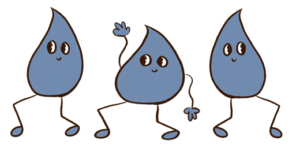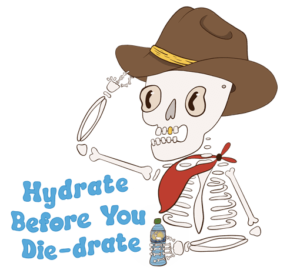Making sure you have enough water is priority number 1 while hiking. It’s always better to have more water than less. Hydrate before you die-drate is what I always say.
I’ve been on hikes where I think I have enough water but I end up having to ration it for the second half of the hike, or even worse, run out. This in not a situation you want to find yourself in.
For the first two years of hiking, I used a few water bottles, but then invested in a sturdy day pack with a water bladder. In case you didn’t know, a water bladder is just a plastic sleeve with an attached a straw/tube that stores 3-5 gallons of water. In a specific day pack hiking bag, these normally have a specific pocket to keep your water bladder separated from your personal items. I am a firm believer, that the brand name of the gear does not matter and you should go with what is accessible to you. You can start with a backpack you have laying around your house and then go to a local super-center/department store and pick up a water bladder. These run from $10-$20 and you can add it to a backpack pocket by adding a hole for the straw to go through so you can access your water while hiking and keeping your backpack on your back. Personally I prefer the water bladder over individual water bottles since it keeps all your water together in an easily accessible pouch. But do whichever is easiest for you! If you’re interested in my hiking gear check out this list.
Now, how much water do you need to pack with you for a day hike?
Typically the bladders are measured in liters. Which is all fine and dandy until you’re an American and you measure your water intake by cups. So to break that down, 1 liter equals a little over 4 cups.
Growing up, I always heard that you should drink 8 cups of water a day. And you might of heard this too. It seems to be the general rule of thumb, and there is certainly some debate in the medical field but it really boils down to each person’s water intake being different and so is their daily water intake, so take this into consideration when planning your hiking water.
You’re also adding in an activity level when hiking, meaning you’ll need more water than normal and there are a few factors to take into consideration: weather, mileage, and elevation change. My general rule of thumb is to bring more water than you actually need. It might seem like a pain and a weight on your shoulders (literally), but I’ve been in situations where I ran out of water and it is not fun in the slightest. So I must emphasize, that this is rather dangerous. So I would much rather hike out with leftover water than be carried out dehydrated because I didn’t have enough.
For me personally, I aim to carry 3 liters for any hike under 10 miles. I do this for several reasons.
- It’s easy. I have a 3 liter water bladder so I fill it up to the brim and don’t give it a second thought. I know I’ll be set for the day and won’t have to worry about running out.
- I wake up and drink coffee. I’m not recommending this but if I’m driving off to some park, coffee is usually the only beverage I’ve had before actually hitting the trail. So even on shorter hikes, I am already starting out a bit dehydrated.
- Again, I’d rather have too much water than too little.
After the trail, my hiking group and I will usually stop at a gas station and pick up a sports drink as a fun little treat to help replenish too.
You’ll need to play around with how much water works for you. So I recommend starting with shorter hikes, noting your water intake, and building from there. Also don’t worry too much about the weight of the water, it gets lighter as you drink it so by the time you’re running out of steam you‘ll have less weight over all. Plus make sure to pack your favorite tasty treats to keep you motivated! Need suggestions? Check out mine!

Remember, Hydrate Before you Die-drate!




